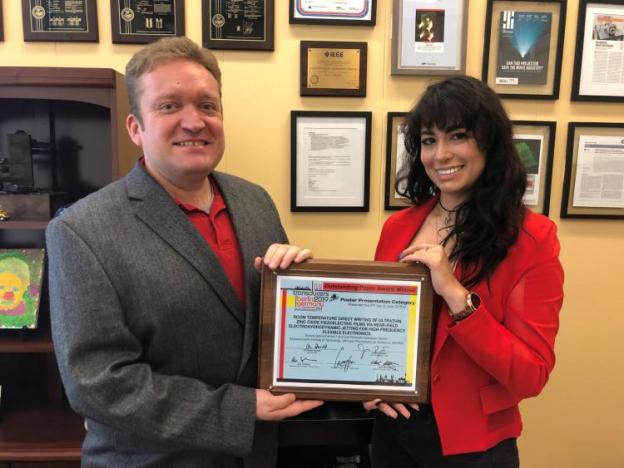
Photo: Dr. Luis Velasquez-Garcia (left), principal investigator, and Brenda Garcia, PhD student from Tec de Monterrey
The paper “Near-Room Temperature Direct Writing of Ultrathin Zinc Oxide Piezoelectric Films via Near-Field Electrohydrodynamic Jetting for High-Frequency Flexible Electronics,” by Brenda García-Farrera and Luis Fernando Velásquez-García won the Outstanding Paper Award – Poster Presentation Category at the 20th International Conference on Solid-State Sensors, Actuators, and Microsystems (Transducers 2019 – Eurosensors XXXIII) last June. The paper reports the first demonstration of room-temperature-printed piezoelectrics capable of GHz actuation, with groundbreaking implications for flexible electronics and soft robotics.
High-frequency devices are key enablers of state-of-the-art electronics used in a wide and diverse range of exciting applications such as inertial navigation, communications, power conversion, medicine, and parallel computing. However, high-frequency, additively manufactured piezoelectric devices are yet to be demonstrated due to shortcomings in the properties of the printed transducing material and the attainable film thickness. In their paper, Brenda and Luis report the first room-temperature-printed, piezoelectric, ultrathin (< 100 nm) ceramic films compatible with high-frequency (> 1 GHz) operation; the printing technique can be used with flexible and rigid, conductive and insulating substrates. The films are made of zinc oxide (ZnO) nanoparticles via near-field electrohydrodynamic jetting, achieving film piezoelectricity without high-temperature processing through a novel mechanism that is controlled during the deposition. The nanostructured films have an average piezoelectric response as high as 21.5 pm/V, which is significantly higher than the d33 piezoelectric coefficient of single-crystal, high-temperature-grown ZnO, and comparable with reported values from ZnO nanostructures. Brenda came as visiting student; she was the first PhD student coming to MIT via the Tec de Monterrey-MIT Nanotechnology Program.
Congratulations to Brenda and Luis for their great achievement!